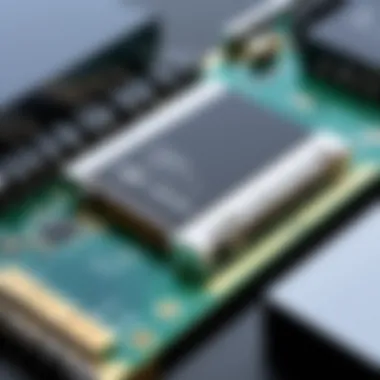Understanding 10GbE SFP+ Network Cards: A Complete Guide


Intro
In the modern digital landscape, the demand for fast and reliable network connections is paramount. The rise of cloud computing, online gaming, and data-intensive applications drive the need for advanced networking equipment. One key component in achieving these speeds is the 10 Gigabit Ethernet SFP+ network card. This guide aims to unravel the complexities surrounding these devices, offering insights into their functionality, advantages, and applications.
Product Overview
Key Features
10GbE SFP+ network cards stand out due to several important features. Firstly, they support data rates of up to 10Gbps, allowing for quick transmission of large amounts of data. Secondly, these cards are often hot-swappable, enabling users to replace them without powering down the system. Additionally, they come in a variety of form factors, including short-range and long-range options, making them versatile for various types of network setups.
Technical Specifications
Understanding the specifications of 10GbE SFP+ network cards is crucial for ensuring compatibility with existing network infrastructure. Key specifications include:
- Data Rate: 10 Gbps
- Connector: SFP+ (Small Form-factor Pluggable Plus)
- Transmission Distance: Depends on the type (typically 300m for short-range, up to 10km or more for long-range)
- Laser Type: Varies between different models (e.g., VCSEL for short-range)
A thorough review of these specifications helps users select the right card for their specific requirements.
Pricing Information
When it comes to pricing, 10GbE SFP+ network cards can vary widely based on the manufacturer and features. Typically, you might find prices ranging from around $150 to over $800 for high-end models. Retailers like Amazon and Newegg provide a range of options, making it easy to compare features and prices.
Performance Analysis
Benchmark Results
Performance evaluations typically feature throughput tests to assess how effectively these network cards can handle data. Common metrics include latency, packet loss, and overall stability under varying loads.
Real-World Use Cases
Real-world applications often involve enterprise environments, data centers, and high-performance computing scenarios. For instance, a company with large data transfers may implement 10GbE connections to optimize their workflow.
Comparison with Competitors
When evaluating the performance of 10GbE SFP+ cards, one should consider alternatives like 10GBase-T network cards or fiber optic solutions. Each option presents distinct advantages and limitations, affecting overall deployment strategies.
Installation and Setup
Required Tools and Components
To install a 10GbE SFP+ network card, you need a few essential tools:
- Screwdriver set to secure the hardware
- Anti-static wrist strap to protect components
Step-by-Step Installation Guide
The installation process generally follows these steps:
- Power down your computer or server.
- Install the card into the appropriate PCIe slot.
- Fasten the card securely with screws.
- Connect necessary cables (copper or fiber).
- Power on the system and install the required drivers.
Troubleshooting Common Issues
Common issues might arise, such as the card not being recognized. Ensure all connections are secure and check compatibility with the operating system. Drivers should always be up to date to avoid conflicts.
Pros and Cons
Advantages of the Product
- High data transfer rates.
- Flexible transmission distance.
- Compatible with various network configurations.
Disadvantages or Limitations
- Higher upfront cost compared to standard options.
- May require additional infrastructure, such as special cables.


Who It’s Best Suited For
This technology is ideal for organizations that handle vast amounts of data frequently, such as cloud service providers, content delivery networks, and enterprises focused on high-speed networking.
Final Thoughts
Summary of Key Points
Recommendations for Potential Buyers
Potential buyers should assess their specific needs, especially the scale of data transfer and existing infrastructure compatibility before making a purchase decision.
Future of the Technology or Product Line
As networking demands continue to rise, advancements in SFP+ technology are expected, with greater data rates and improved features likely on the horizon. Keeping informed about market trends will be essential for making strategic purchasing decisions.
Prelims to 10GbE SFP+ Network Cards
10GbE SFP+ network cards play a significant role in modern networking. These devices are crucial as they provide high-speed data transfers. They cater to the increasing demand for bandwidth in various environments, including data centers, enterprises, and high-performance computing.
SFP+ stands for Small Form-Factor Pluggable Plus, and these network cards allow flexibility in connectivity options. Users can choose different transceivers to suit their requirements without needing to change the whole card. This adaptability makes SFP+ network cards a versatile choice for many networking tasks.
What is a 10GbE SFP+ Network Card?
A 10GbE SFP+ network card is designed to connect a computer or server to a 10 Gigabit Ethernet network. It enables high-speed internet connectivity. These cards can plug into a compatible port in a switch or router. The design allows for hot-swapping, which means they can be replaced without turning off the device. This feature is important for systems that require high availability and minimal downtime.
Typically, a 10GbE SFP+ network card uses LC connectors. These connectors come in different types, such as single-mode and multi-mode optical fibers. The selection of the right connector impacts distance and signal quality. Overall, the 10GbE network card is vital for network infrastructure, ensuring fast and efficient communication.
Historical Context and Evolution
The evolution of network cards reflects the rapid advancement in technology. In the early days of networking, speeds were limited to 10 Mbps or 100 Mbps. As data demands grew, so did the need for faster connection options. Ethernet technology has come a long way since then.
The introduction of gigabit Ethernet marked a significant leap forward. Following that, the development of 10 Gigabit Ethernet emerged. The early 2000s saw the first deployment of SFP+ technology. Since then, data rates have continued to increase. Network infrastructure had to adapt to support these changes.
Today, 10GbE SFP+ network cards are widely used across various sectors. Their rise reflects an ongoing trend towards high-speed networking solutions, driven by the growing needs for data transfer and real-time access to information.
"Understanding the evolution of the SFP+ technology is key to grasping how modern networks are structured and optimized for performance."
Technical Specifications
Understanding the technical specifications of 10GbE SFP+ network cards is essential for anyone looking to implement or upgrade their networking solutions. These specifications provide critical insights into the performance, compatibility, and overall effectiveness of network cards in real-world environments. With the rapid advancements in technology, knowing these details enables users to make informed choices that meet their specific needs.
Data Transfer Rates
Data transfer rates are a defining characteristic of 10GbE SFP+ network cards. They typically support data rates of 10 Gbps, which is substantial compared to standard Gigabit Ethernet options. These high data rates facilitate faster data transmission, reducing bottlenecks that can hinder network performance.
The 10GbE technology uses multiple encoding schemes to maintain efficiency over various media types, improving user experience significantly. As businesses continue to rely more on data-intensive applications, such as cloud computing and video streaming, understanding this specification becomes crucial for maintaining seamless operations.
Connector Types Available
Different connector types allow for versatility in network environments. The choice of connector impacts installation ease, performance, and overall effectiveness of a network card. Let's take a closer look at the most common connector types used with 10GbE SFP+ network cards.
Connector
The LC connector is a widely used option in networking due to its compact design and reliability. It offers a small form factor, making it suitable for high-density environments where space is a constraint.
One prominent feature of LC connectors is their duplex design, which allows for simultaneous data transmission in both directions. This characteristic enhances overall performance in 10GbE networks, offering a practical solution for many organizations. However, it may require adapters for compatibility with other setups, depending on existing infrastructure.
SC Connector
The SC connector is another popular choice, known for its durability and ease of use. This connector also offers a push-pull design, which simplifies the connections and disconnections, making installation more efficient.
Its key characteristic is the larger size in comparison to the LC connector, which can make it less favorable in high-density networking applications. However, the SC connector is often more robust, providing reliable connections over longer distances while experiencing less signal loss.
MT-RJ Connector


The MT-RJ connector is less common compared to the LC and SC options but offers notable benefits. It supports both a smaller footprint and simpler installation due to its unique design that integrates both transmit and receive functions in one connector.
The integrated design of the MT-RJ connector reduces the number of cables needed, which can simplify organization in network setups. That said, its adoption has declined in favor of LC connectors due to availability and compatibility issues within mainstream applications.
Supported Protocols
Supported protocols represent another significant aspect of 10GbE SFP+ network cards. These cards are designed to work with various protocols such as Ethernet, Fibre Channel, and others, providing flexibility in different environments.
Understanding which protocols are supported allows users to optimize their network setups according to their communication needs. This flexibility can be vital for organizations with diverse networking requirements. With the right understanding of technical specifications, users can greatly enhance their networking efficiency.
Importance of 10GbE SFP+ Network Cards
10GbE SFP+ network cards represent a significant technological advancement in networking capabilities. Understanding their importance is crucial for anyone involved in network design or management. These cards facilitate higher bandwidth and faster data transfer rates, which are increasingly necessary in today’s data-driven world.
Enhanced Network Performance
Enhanced performance is one of the most prominent benefits of 10GbE SFP+ network cards. They enable faster data throughput compared to previous standards like 1GbE. This increase in speed supports applications that demand large data transfers, such as video streaming, cloud computing, and real-time data analytics.
With a maximum data transfer rate of up to 10 Gbps, these network cards reduce latency. Reduced latency is crucial in environments where every millisecond counts. For example, in financial trading platforms, even the slightest delay can lead to significant financial loss. Thus, incorporating 10GbE SFP+ can provide a competitive edge.
In addition, the cards support multiple data transmission protocols, enhancing their utility across various platforms and applications. As a result, organizations can maximize their existing infrastructure while improving overall network efficiency.
Scalability Options
Scalability is another essential aspect of 10GbE SFP+ network cards. In an era where data needs are continuously growing, organizations must invest in technology that can adapt to future demands.
These network cards allow for easy upgrades without requiring complete system overhauls. For businesses planning to expand, this characteristic is a significant advantage. They can start with a modest setup and, as data traffic increases, scale up the network performance by simply upgrading the SFP+ modules or switches without extensive rewiring or hardware changes.
Furthermore, many 10GbE SFP+ network cards support a variety of transceiver modules, enabling users to choose the right option for their specific needs. Whether it is copper or fiber-optic cables, the versatility allows organizations to select the best solution for their environment.
Compatibility and Installation
Understanding the compatibility and installation of 10GbE SFP+ network cards is crucial for achieving optimal performance in networking environments. Proper selection of compatible hardware ensures that the network cards can operate effectively within the system архитектуре. Additionally, a smooth installation process minimizes potential downtime and technical issues, allowing users to quickly harness the benefits of 10GbE speeds.
Choosing Compatible Hardware
When integrating 10GbE SFP+ network cards into existing systems, it is essential to verify hardware compatibility. Consider these key factors:
- Motherboard Compatibility: Check if the motherboard has the necessary PCIe slots to accommodate the 10GbE SFP+ network cards. It is recommended to consider the version of PCIe as well, ensuring it aligns with the requirements of the cards.
- Network Infrastructure: Evaluate the existing switches, routers, and other networking components. These devices must also support 10GbE connections to make full use of enhanced speeds offered by SFP+ technology.
- Cabling: The type of cables used, such as CAT6a or fiber-optic cables, plays a critical role in performance. Confirm that your cabling supports the transfer rates and distances intended for your networking setup.
- Power Supply: Ensure that the system's power supply can handle any additional demands from the new network cards. Insufficient power can lead to instability and performance issues.
Addressing these factors can prevent potential issues during installation and ensure efficient operation post-installation.
Installation Procedure
Installing 10GbE SFP+ network cards is a straightforward process, but precision is important. Here are the steps to follow for a successful installation:
- Preparation: Before beginning, power down the system and unplug it from the source. This step is crucial for safety.
- Open the Case: Remove the side panel of the computer case to gain access to the motherboard. Keep screws and components secure to ease reassembly.
- Locate PCIe Slot: Find an unused PCIe slot on the motherboard. It is often advisable to use the slot closest to the CPU for optimal performance.
- Insert the Network Card: Align the connectors of the 10GbE SFP+ network card with the slot and gently press down until it is securely in place. Ensure that the card is level to prevent damage.
- Secure the Card: Use screws to secure the card to the chassis. This step stabilizes the card and prevents it from moving during operation.
- Reassemble the Case: Once the card is secure, replace the side panel of the case and reconnect all cables.
- Power On the System: Turn on the computer and allow it to boot up. The operating system should recognize the new hardware.
- Install Drivers: Follow the manufacturer's instructions to install any necessary drivers. This ensures that the network card operates correctly within the system ecosystem.
- Test the Connection: After installing drivers, test the network connection to confirm that everything functions properly. This step can include checking network speeds and connectivity with other devices.
By following these steps, users can efficiently install 10GbE SFP+ network cards and ensure they are fully compatible with their existing hardware.
Advantages of 10GbE SFP+ Network Cards
The adoption of 10GbE SFP+ network cards has become increasingly common as organizations demand higher network speeds and reliability. This section explores key advantages of 10GbE SFP+ network cards, focusng on important features such as lower latency and cost-effectiveness in the long run. Understanding these benefits is vital for organizations that aspire to enhance their networking infrastructures and optimize performance.
Lower Latency
Low latency is one of the most critical advantages of 10GbE SFP+ network cards. These cards, designed for high-speed data transfer, significantly reduce lag times that can affect network performance. When deploying applications that require real-time data exchange, such as financial trading platforms or gaming servers, a swift response is essential. The ability to minimize latency results from the inherent design of these network cards, which efficiently manage data packets.
- Reduced delay in communication between devices.
- Improved user experience in applications that depend on immediate data processing.
- Essential for mission-critical operations where every millisecond counts.
This lower latency not only improves user satisfaction but also enhances overall system reliability. Organizations often find that adopting 10GbE SFP+ network cards eliminates bottlenecks and is best for high-performance computing tasks. As networks evolve, the need for speedier interactions will only increase, making this advantage crucial.
Cost-Effectiveness in the Long Run


Another significant benefit of 10GbE SFP+ network cards is their cost-effectiveness when considering long-term investment. Although initial expenditures may be higher than traditional network cards, the efficiency and performance gains justify this cost. Businesses can experience substantial savings in various ways:
- Reduced Infrastructure Costs: 10GbE SFP+ cards can handle more data over existing cabling, which can lessen the need for extensive infrastructure upgrades.
- Lower Energy Consumption: These cards often consume less power relative to the output they provide, leading to savings in energy bills.
- Increased Productivity: Enhanced network speed and lower latency results in higher productivity levels for employees. Applications run faster, reducing downtime and delays.
Adopting 10GbE SFP+ network cards creates a viable path for future expansions as organizations continue to scale their network capabilities. When carefully considered, this investment can represent a smart financial decision that aligns with long-term growth strategies.
In summary, the advantages of lower latency and cost-effectiveness make 10GbE SFP+ network cards essential for any serious networking environment. As networks continue to evolve, these cards offer a robust solution for improved performance and reduced costs over time.
Use Cases for 10GbE SFP+ Network Cards
Understanding the use cases for 10GbE SFP+ network cards is vital for those looking to enhance their networking systems. These cards serve as powerful tools that enable high-speed data transmission, critical for various applications. Notably, deploying 10GbE SFP+ cards can lead to significant performance improvements in both data center environments and high-performance computing settings. Each use case offers unique benefits that can lead to optimized network efficiency and productivity.
Data Centers and Enterprise Networks
In data centers and enterprise networks, the need for rapid data transfer is paramount. 10GbE SFP+ network cards fulfill this requirement by allowing for a faster connection between servers and networking devices. With these cards, organizations can handle the increasing load of data generated by applications, cloud services, and user demands. This capability is key to reducing bottlenecks and accelerating data accessibility, paramount in today's fast-paced digital landscape.
The typical configurations in data centers often depend on switching infrastructure. Every switch must handle substantial data throughput, often measuring in terabits per second. This is where the role of 10GbE SFP+ cards becomes crucial. They enable a seamless integration into existing network architectures, facilitating a high-speed backbone that enhances overall performance.
Here are some benefits observed in data centers that utilize 10GbE SFP+ network cards:
- Increased Bandwidth: Supports larger volumes of data, essential for applications like virtualization.
- Scalability: Adjusts to growing networks without the need for comprehensive overhauls.
- Reliability: Generally more robust than older standards, reducing downtime.
In addition, the application of 10GbE SFP+ cards aligns well with technologies that demand consistent performance, such as big data analytics and extensive storage solutions. This specific integration can lead to efficient resource allocation and better management of data traffic, enhancing user experiences across platforms.
High-Performance Computing Environments
High-performance computing environments require optimal performance to process vast quantities of data effectively. 10GbE SFP+ network cards are particularly valuable in these settings due to their ability to support intensive workloads and minimize latency. Their architecture allows for immediate access to data, ensuring that computations are performed without unnecessary delays.
These environments include tasks like simulations, scientific computation, and advanced data analysis. The significant computing power demanded in these tasks necessitates a network infrastructure that can keep pace. Here, 10GbE SFP+ cards enable flexible, high-speed connections, integral for real-time data processing.
When analyzing their use in high-performance computing, consider these aspects:
- Enhanced Throughput: Facilitates multi-threaded processing, beneficial for complex simulations.
- Reduced Latency: Important for applications that require immediate results, such as financial trading.
- High Data Integrity: Maintains data accuracy and minimizes loss during transfer.
To summarize, in both data centers and high-performance computing environments, the adoption of 10GbE SFP+ network cards leads to optimized performance, reliability, and efficiency. It is evident that their role is critical for organizations aiming to stay ahead in a complex, data-driven world.
Market Insights
Understanding the market landscape for 10GbE SFP+ network cards is crucial for making informed decisions. These insights encompass various elements such as technological advancements, competitive dynamics, and consumer preferences. They not only help in identifying current trends but also assist buyers in evaluating future needs.
Market insights are particularly valuable as they reveal the trajectory of the tech landscape. This includes shifts in demand, which may be attributed to increasing data consumption across enterprises and personal users. Many users look for options that balance performance and cost-effectiveness. Recognizing these patterns allows both manufacturers and consumers to align their strategies with what is realistic and beneficial.
Current Trends and Innovations
Recent years have shown a rapid evolution in 10GbE SFP+ network card technology. Currently, there is a trend towards enhancing energy efficiency and speed. Industry players are investing more in research to develop low-power solutions that do not compromise performance. Innovations are also evident in the use of optical transceivers. These components enhance the range and speed of data transmission while reducing the physical footprint of network setups.
- Energy-efficient designs: Companies are focusing on creating cards that consume less power while delivering high speeds. This not only benefits users but also helps in reducing operational costs.
- Multi-rate capabilities: Newer models often support multiple rates, like 10 Gbps, 25 Gbps, or even 40 Gbps, providing flexibility for evolving network needs.
- Integration with virtualization technologies: There is a growing synergy between networking hardware and software-defined networking (SDN). This allows for improved management and optimization of network resources.
Staying abreast of these advancements can offer a competitive edge in understanding what products will best serve specific networking needs. This includes deciding when to upgrade existing infrastructure or adopt new technologies based on the development cycle.
Major Manufacturers and Product Offerings
The market for 10GbE SFP+ network cards is dominated by a few key players. Manufacturers like Cisco, Intel, and Mellanox Technologies contribute significantly to this landscape with diverse product offerings. Each brand has unique advantages that cater to different segments of the consumer market.
- Cisco: Known for its robust networking solutions, Cisco offers a range of 10GbE SFP+ cards. Their products are generally noted for reliability and features tailored for enterprise environments.
- Intel: Intel provides network cards that emphasize high performance and energy efficiency, contributing significantly to data center operations.
- Mellanox Technologies: Specialized in high-performance networking, Mellanox’s SFP+ offerings often target demanding environments like cloud computing.
This comprehensive view enables buyers to choose the right network card based on specific needs and application requirements. Not only does it help in aligning technology choices with business goals, but it also assists in cost management over the product's lifecycle.
Staying aware of market insights ensures consumers can adapt to changes and make informed purchasing decisions.
Finale
Summary of Key Points
In this article, we explored the multifaceted world of 10GbE SFP+ network cards. We dissected their technical specifications, their significance in enhancing network performance, and the growing compatibility with a range of hardware. Key benefits such as lower latency and cost-effectiveness were also highlighted. Furthermore, the in-depth analysis of use cases provided insights into how various industries leverage these network cards for optimal performance. The importance of selecting compatible hardware cannot be understated, as it directly impacts installation success and overall functionality.
Future Outlook
As we look ahead, the future of 10GbE SFP+ network cards appears promising. With continuous advancements in technology, we can anticipate innovations in data transfer rates and enhanced protocol support. Emerging trends suggest an increase in demand for high-speed networking solutions across sectors, from data centers to high-performance computing environments. As the world leans more on cloud computing and big data analytics, the relevance of such network cards will only grow, ensuring they remain integral to modern networking infrastructures. Manufacturers are likely to invest in research and development, fostering products that improve efficiency and user experience.
In summary, understanding the dynamics surrounding 10GbE SFP+ network cards equips users and professionals to make intelligent decisions regarding their networking setups and future-proof their investments.



